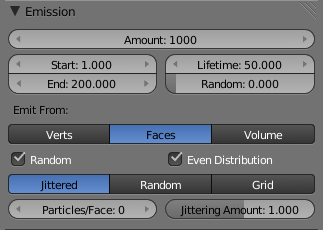「Doc:2.6/Manual/Physics/Particles/Emission」の版間の差分
(→Distribution Settings) |
(相違点なし)
|
2014年11月13日 (木) 10:52時点における版
Particle Emission
The Emitter system works just like its name says: it emits/produces particles for a certain amount of time. In such a system, particles are emitted from the selected object from the Start frame to the End frame and have a certain lifespan. These particles are rendered default as Halos, but you may also render these kind of particles as objects (depending on the particle system’s render settings, see Visualization).
Options
The buttons in the Emission panel control the way particles are emitted over time:
- Amount
- The maximum amount of parent particles used in the simulation.
- Start
- The start frame of particle emission. You may set negative values, which enables you to start the simulation before the actual rendering.
- End
- The end frame of particle emission.
- Lifetime
- The lifetime (in frames) of the particles.
- Random
- A random variation of the lifetime of a given particle. The shortest possible lifetime is
Lifetime×(1-Rand). Values above 1.0 are not allowed. For example with the default Lifetime value of 50 a Random setting of 0.5 will give you particles with lives ranging from 50 frames to50×(1.0-0.5)=25 frames, and with a Random setting of 0.75 you’ll get particles with lives ranging from 50 frames to50×(1.0-0.75)=12.5 frames.
Emission Location
Emit From parameters define how and where the particles are emitted, giving precise control over their distribution. You may use vertex groups to confine the emission, that is done in the Vertexgroups panel.
- Verts
- Emit particles from the vertices of a mesh.
- Faces
- Emit particles from the surface of a mesh's faces.
- Volume
- Emit particles from the volume of an enclosed mesh.
Distribution Settings
These settings control how the emissions of particles are distributed throughout the emission locations
- Random
- The emitter element indices are gone through in a random order instead of linearly (one after the other).
For Faces and Volume, additional options appear:
- Even Distribution
- Particle distribution is made even based on surface area of the elements, i.e. small elements emit less particles than large elements, so that the particle density is even.
- Jittered
- Particles are placed at jittered intervals on the emitter elements.
- Particles/Face
- Number of emissions per face (0 = automatic).
- JitteringAmount
- Amount of jitter applied to the sampling.
- Random
- Particles are emitted from random locations in the emitter’s elements.
- Grid
- Particles are set in a 3d grid and particles near/in the elements are kept.
- Invert Grid
- Invert what is considered the object and what is not.
- Hexagonal
- Uses a hexagonal shaped grid instead of a rectangular one.
- Resolution
- Resolution of the grid.
- Random
- Add a random offset to grid locations.
- Use Modefier Stack
- Emit particles from mesh with modifiers applied (must use same subsurf level for viewport and render for correct results)
| Your mesh must be watertight to emit particles from the volume. | |
| Some modifiers like Edge Split break up the surface, in which case volume emission will not work correctly! |
